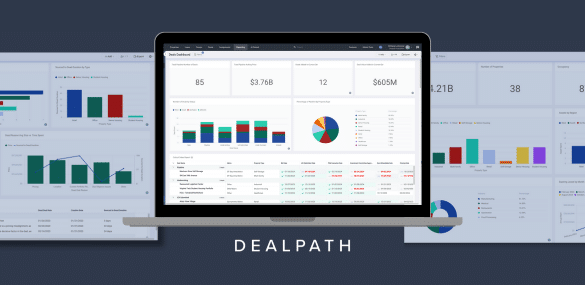Portfolio growth is one of the clearest signals of success for commercial real estate investment managers, but it’s far from the only metric that you can look to for performance insights. You can’t manage what you can’t measure, which means firms that are reliant on generic project management tools and Excel for pipeline tracking often miss key strategic insights. Purpose-built software, however, provides heightened visibility into a trove of operational metrics, which are valuable growth drivers. Managing deals in Dealpath, firms can better understand key baseline metrics–which indicate how their pipeline is faring–to set new goals and make strategic decisions about process, workflows and more to drive portfolio growth.
Read on to learn about the metrics that Dealpath clients–from institutional giants like Nuveen, Blackstone and Oxford Properties to powerhouse teams like Avanath–measure to guide growth initiatives.
Jump to:
- The Importance of Standardized Data Fields in Strategic Reporting
- Number of Deals Evaluated
- Number of Deals Closed
- Close Rate
- Deal Velocity
- Deal Lifecycle Metrics
- Cash-on-Cash Returns
- Number of Deals Passed
The Importance of Standardized Data Fields in Strategic Reporting
Unfortunately, most firms are not equipped to learn from operational metrics due to unstandardized data. Inconsistent formatting and disparate data storage ultimately limit how firms can evaluate their efforts and success.
Managing deals in Dealpath, however, firms have more visibility into how deal teams are operating. Standardizing data fields ensures that firms can reference any data point, while enforcing data hygiene.
Armed with this visibility, senior management can quantify their performance through new lenses and make more strategic decisions about which deals to pursue.
7 Baseline Metrics Deal Teams Are Tracking in Dealpath
1. Number of Deals Evaluated
How many deals is your firm sourcing?
The number of deals that your firm evaluates is a baseline indication of your deal teams’ efforts. Through powerful reporting and intuitive dashboards in Dealpath, you can easily learn how many deals your deal team evaluated in a certain timeframe, or filter down by type for a more granular view. The more deals you review, the more potentially profitable opportunities you can close on.
After building a baseline, your firm can be more goal-oriented about its targets. As firms screen deals faster and build new efficiencies, they can scale their pipelines, often without hiring.
After 1 year managing deals in Dealpath, Avanath doubled its pipeline of deals reviewed.
2. Number of Deals Closed
How many deals make it through the pipeline?
Similarly, the number of deals that deal teams fully execute and close on can also offer visibility into growth. Executing deals successfully takes diligence, attention to detail, and laser-focused collaboration. Dealpath reduces the burden on deal teams by introducing operational efficiencies across these categories, helping firms to close more deals. Closing even a few more deals each year can generate tremendous portfolio growth, laying the groundwork for ongoing scalability.
After 1 year managing deals on Dealpath, Avanath had twice the number of deals under contract in a record year.
3. Close Rate
Of the deals that you sourced, how many closed?
Examining the number of deals closed is valuable, but the close rate can illuminate other opportunities. This metric helps firms understand the baseline number of deals that successfully closes compared to the number they sourced. Ultimately, it can help guide decisions about which deals to pursue and which to deprioritize.
Without a systematic process or software, calculating this number takes communication, file sharing and manual work. Firms that manage their deals In Dealpath, however, can determine their close rates in just a few clicks. You can also filter down to see how the close rate differs by market, deal type and size. If the close rate is higher in certain categories, it makes sense to prioritize them. Once you understand your close rates, you can set incremental targets to improve this metric.
In 2021, a regional multifamily owner/operator Dealpath client closed 100% more deals.
4. Deal Velocity
At what pace are deals moving through the pipeline?
Even as the broader market is moving faster to capitalize on hot asset classes like life sciences, deals take time to screen, execute and close. Closing deals at a higher velocity enables you to seize profitable opportunities before investors, while also leaving valuable time to review more deals. That’s why relying on centralized data and standardized workflows is vital to expediting decision-making.
In 2021, a regional multifamily owner/operator Dealpath client saw a 56% increase in deal volume and velocity.
5. Deal Lifecycle Metrics
How long does each phase of the deal last, and why?
Metrics related to the deal lifecycle–or how long certain phases of the deal last–can tell an insightful story about deal flow. Auditing the length of each stage enables firms to identify blockers, then work to resolve them. Unless you can view how long due diligence typically lasts, or how quickly legal teams tick their boxes, you can’t recommend process changes that expedite deal flow.
In Dealpath, firms can track lifecycle metrics related to their own designated deal stages, such as:
- Time to close
- Deal creation to LOI submission
- Deal creation to bid
6. Cash-on-Cash Returns
How much revenue did your firm generate based on the cash invested?
It’s no secret that cash-on-cash returns are a widely tracked bottom line metric, but, can your firm compare these returns across asset types, locations and other variables? Centralizing pipeline and portfolio data in one command center enables firms to build granular reports to identify which deals and asset types yield the highest returns.
Do industrial deals actually generate higher returns based on the cash initially invested? On average, which markets are the most profitable? With heightened visibility into cash flow, decision makers can strategize about how to better amplify that success.
7. Number of Deals Passed
How many deals did your team review and ultimately not close?
Every deal you review is an opportunity to grow your portfolio and generate top-line revenue, but are you evaluating the right deals? Analyzing the number of deals passed–together with the deal types, markets and other data–can guide strategy and decision making. If your firm has a pattern of rejecting certain deals, pursuing them may no longer be worthwhile. For example, if your firm reviewed 200 hospitality deals last year and none closed, does it still make sense to prioritize that deal type?
The 6 CRE Report Types that Leading Deal Teams Look At
Your pipeline data carries endless value in screening new deals and setting strategic priorities. The challenge that investors face, however, is assessing that data in a scalable manner.
Watch our on-demand webinar now to learn about the 6 report types that leading deal teams routinely review to turn data into answers.
Watch the Webinar




